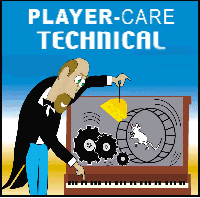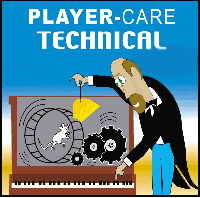
|

|

|

|

|

|
| Home | Manuals | Supplies | Search | Consult | Contact | Testing | Service |


Player Piano with Otto Higel Action |
|
In my continuing effort to find or create technical literature about all known player systems, I'm again involved in a project concerning a Gerhard Heintzman player piano with what I've been told is one of many Otto Hegel variations or the Heintzman player system. I have taken special interest in this particular piano because of a few of its odd components. After spending a couple of weeks looking at various pictures of the system and working via email correspondence with the owner, I came to the conclusion that it was time to reach out to the MMDigest for help. So, I made up this page, with the pictures below, and sent my request to the Digest on December 30, 2013. Due to the New Years holiday, the posting didn't get sent out the the MMDigest members until January 2, 2019, but almost immediately (or so it seemed) responses came in from Tom Binnall, Ian Mavor, Alan Turner, and Ken Vinen. They all agreed that the player system was a variation of the Otto Higel action, and they all had bits and pieces of information which allowed me to continue working on the tubing diagram. A few things were obvious from the start. First, it has a split stack. Second, it utilizes Theme perforations for some degree of Expression control. Third, it also has Pushbuttons which I believed were also used to control the Expression. Fourth, it has Automatic Sustain. Fifth, it has a four-hole tracking device. What the gentlemen listed above helped figure out was the purpose and function of the odd switch on the back of the spoolbox, the purpose and function of the pushbutton in the center of the user controls (in front of the keys), and clarification concerning the three pushbuttons on the left end of the user controls. Next, I'll address all three in order of complexity from the easiest to the most complex. Once I was made aware of the fact that the three pushbuttons on the left performed that same functions as perforations on a music roll with Theme 'snakebite' perforations and sustain perforations, it was a simple matter to 'T'ee the tubing from the pushbuttons into the tubing for those functions. Next was the pushbutton in the center. Somewhat to my surprise, I was told that it's function was for "Silent" or "Fast Forward" operation of the system. That cleared up a lot of questions and it also started unraveling the mystery of the odd switch on the back of the spoolbox. As it turns out, all of the operations that must take place during Rewind also take place when the 'Silent' feature is activated, which the exception of the shifting of the transmission from Play to Rewind. The functions that get activated by the Silent button are: Stack Cut-Out for both the Bass and Treble registers, and the Fast Reroll port in the Air Motor Governor. During normal Rewind, the same functions that are activated by the Silent button get activated by a port on the odd switch, which I have since named the Rewind Switch. Last we come to the Rewind Switch. It serves three purposes, which once known are actually quite logical (Columbus' Egg). First, as previously stated, it supplies the signal to activate the two stack cut-out valves and the fast reroll port. Second, it turns off the signal path for the Auto-Sustain device, which prevents it from responding to the sustain perforations on the music roll during Rewind. Third, it supplies a common signal to all four ports of the automatic tracking device. This action causes the tracking device to 'self-center' during Rewind. The only questions that remain at this point in time are (1) Where is the valve that operates the Auto-Sustain? and (2) Does the tracking device use vacuum or atmosphere during Rewind for the self-centering feature. Also, although we know it has to be somewhere, we still haven't seen the Air Motor Governor bellow. It's assumed, at this point, to be on the backside of the exhauster assembly along with the vacuum supply connection for the air motor -which has yet to be located. Sadly, the owner of the piano has very little knowledge concerning player pianos (although he seems like an intelligent individual). So, getting him to test the various components in the system has been somewhat of a challenge. Basically, I've been writing fairly detailed test procedures for each of the components and explaining how to access certain areas of the system that I need to see. As a result of those efforts and all of the information that came in on January 2nd, I've come up with a fairly decent tubing diagram. Current Tubing Diagram (This diagram will continue to change until it is finished.) I have chosen to use the .GIF format for the diagram because the .JPG format optimizes the colors and reduces the clarity. However, if you like, I will gladly convert it to the .JPG format and send you a copy. If you can provide any information about the player system in the piano, please use the 'Contact John Tuttle' link above or write to me at my business address: john at player dash(-) care dot com. I have other pictures of the various components in the system, and I would be more than happy to send them upon request. Just let me know what you'd like to see.
|

|
Since "Player-Care" is an internet business, I prefer that we correspond via E-Mail (click here to fill out the 'Request Form'). However, if I'm not in the middle of some other activity, you can reach me at 732-840-8787. But please understand that during the hours from 8AM-5PM EST (Mon-Sat), I'm generally quite busy. So, I probably won't answer the phone. If you get the answering machine, please leave a detailed message stating the reason for your call. Also, repeat your name and phone number clearly and distinctly. By necessity, I prioritize everything in my life. And, if you call and just leave your name and number, and ask me to call you back, it might be a day or two before I return your call. Why? Because I don't know why you want me to call and I might not be prepared to assist you in an effective and efficient manner. If you leave me an E-Mail address (which I prefer), spell it out phonetically. The more you do to help me, the more I can help you in return. Don't rush. You have four minutes to record your message. |
|
407 19th Ave, Brick, NJ, 08724 Phone Number 732-840-8787 (Voicemail Only, No Texts) |
